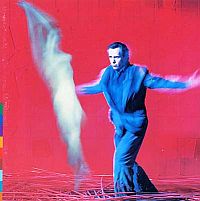An Appreciation of Peter Gabriel's "Us"

This is, without a doubt, my favourite album of all time. While many longtime Gabriel fans will cite 1986's "So" as his artistic pinnacle, it's 1992's "Us" that does the trick for me. Why is that? Bear with me here.
Yes, it's "So" that delivered real commercial success, with its trio of chart-busting singles ("Sledgehammer", "Big Time", "In Your Eyes"), polished art-rock aesthetic and Gabriel’s strongest songwriting to date. Consequently, "So" was so triumphant that anything that followed would inevitably be compared to its commercial and critical accomplishments, and, consequently, forever be overshadowed by its aura. Therefore, when Gabriel finally dropped "Us" six long years later, the general response was predictably muted and indifferent.
In retrospect, it was completely understandable why the initial reaction to "Us" was considerably less than enthusiastic. Severely lacking in any prospective, hooky radio singles, shrouded with a perfectionist, solemn production sheen, and caught up in an exacting, unrepentant fug of introspection, Us was a decidedly more challenging piece of work than "So", which led to some speculation that Gabriel had finally reached the end of his tether. Bandwagon fans who jumped aboard during the "So" carnival quickly searched for the nearest Stop sign.
Nevertheless, take a closer look at "Us", and much of the criticism turns out to be unwarranted. Yes, it might not be as immediately engaging as "So", but there are so many more layers to it than any of Gabriel’s preceding records. While "So" has a dynamic urgency that endeared itself to listeners instantaneously, "Us" reveals its treasures more gradually and luxuriously.
Its intricate, innovative textures are a collective wonder to behold: Gabriel’s prodigious sense of experimentation is in full flight here, and while the official follow-up, 2002’s "Up" (which came a staggering full decade after "Us"’s initial release), was an even more complex affair, it somehow lacked the unifying concept that is at the heart of "Us".
The concept in question was romantic dysfunction, stemming from Gabriel’s then-recent divorce from wife Jill, and his subsequent failed relationship with actress Patricia Arquette. As befitting the general premise, Gabriel eschewed any of his usual abstract noodlings (especially on the first Peter Gabriel, which was musically schizophrenic to a fault), instead opting for a cohesive thematic entirety which fleshes out the ideas that he has meticulously laid the table with.
"Come Talk to Me" makes for a fantastic beginning to the collection, its head-spinning, genre-defying swirl of textured synths, crashing percussion, keening bagpipes, Armenian wind instruments and a traditional Russian folk choir still making for one of the most breathtaking moments in Gabriel’s oeuvre.
Second track "Love to Be Loved" is just as powerful, if more subdued in temperament: a mid-tempo meditation on the primal need to be loved, anchored by a gentle, rhythmic tabla pulse and marked by Gabriel’s yearning, tortured tenor.
"Blood of Eden", if you must, is this album’s counterpart to "Don’t Give Up", Gabriel’s delicate duet with like-minded songstress Kate Bush from "So": a gentle, acoustic-guitar and violin-led ballad dwelling on the different emotional dispositions of men and women, with an uncharacteristically restrained Sinead O’Connor providing backing vocals.
Meanwhile, "Only Us" is a quietly bitter rumination on the aftermath of a failed relationship, with processed electric-guitar fills and an understated but busy percussion bedrock.
Things get even more pensive with "Washing of the Water", a virtual Bible belt hymn, complete with a soundalike Muscle Shoals horn section and an evocative lyric that brings to mind some of the more accessible Sacred Harp chants.
On the other hand, "Digging in the Dirt" is arguably the disc’s highlight: a palpable statement of rage and hurt, with mercurial, powerhouse guitar chords, disturbing found-sound effects and one of Gabriel’s best and darkest vocal performances ever.
But it’s not all contemplative navel-gazing and embittered reminiscing here. Gabriel also lets loose with a couple of energetic, visceral rockers, which, while not constituting instantaneous candidates for radio play, were welcome changes of pace in the otherwise sombre proceedings.
"Steam" is a lumbering, ballsy, funk-infused behemoth that is basically a sexed-up descendant of the earlier, massive "Sledgehammer". "Kiss That Frog" practically revels in its sly retelling of the frog-prince fairytale, strutting by smugly in its kinetic Cameroonian-percussion groove and exuberant carnival-style organ lines.
And only the cathartic, widescreen "Secret World" can provide a thoroughly appropriate ending to what has been an extraordinary record so far. A liberating proclamation of healing and acceptance, "Secret World" is underpinned by a simple but effective percussive loop and a heartbeat-throb bass line, above which rides a clutch of melodic piano chords, some minimalist electric-guitar patterns, and Gabriel’s most sympathetic singing on the entire album.
So…"Us" might not be as commercially lauded as "So", but in many other ways, it’s a more robust and consistent effort than its antecedent. Most critics will still point out the inherent, studied seriousness of "Us" as its most glaring shortcoming, but it’s only a deficiency if it’s compared, oftentimes unfairly, to "So".
Only the most churlish observer would cite "So" as Gabriel’s most consummate endeavour in a repertoire studded with numerous jewels. At the end of the day, "Us" has to be viewed as what it really is: a brilliant example of Gabriel’s dependably idiosyncratic sensibilities, and that rare musical creature - a near-perfect blend of modern musical technology and good old-fashioned soul.
And that's why I love it to bits.

0 Comments:
Post a Comment
<< Home